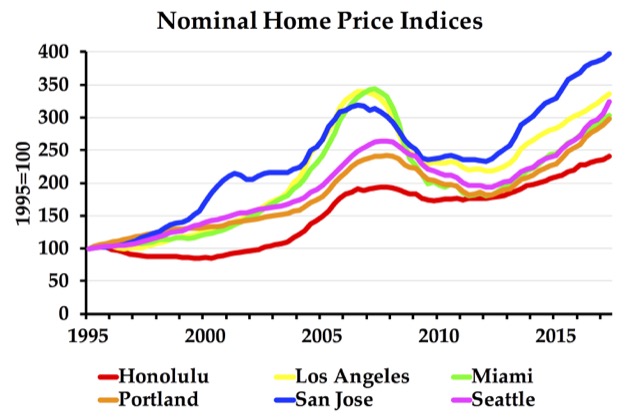
Someone just paid $1.1 million for a tear-down/fixer-upper in Mountain View, California. That’s not really news, as prices in Silicon Valley have been increasingly outrageous. What’s news is that they bought the house with the provisos that the existing owner will get to live there for seven years; the buyer didn’t get to see the interior of the home; and the buyer is required to make improvements before closing on the home. As the San Francisco Chronicle says, the new owner probably figures it will take seven years to get the permits to rebuild the house anyway.

The problem for the buyer is that the same forces that have made housing prices rise in Silicon Valley–namely the urban-growth boundaries adopted by San Mateo and Santa Clara counties–have also made prices more volatile. In other words, what goes up will come down. As shown in the chart above, San Jose prices today are already higher than they were at the peak of the 2006 housing bubble, indicating that another bubble is likely to deflate fairly soon.
The above chart is based on the latest home price indices published by the Federal Housing Finance Agency, and in particular the all-transactions index for metropolitan areas. These data are collected using the Case-Shiller method, but cover more areas than the official Case-Shiller index.
The Antiplanner has modified this file, and the one for states, to make it easy to make charts such as the one above for any group of up to six metropolitan areas or states. Simply download the Antiplanner’s files for metropolitan areas and/or states and go to cells AQ72 for the metropolitan areas file and BO212 for the states file for instructions on modifying the charts. The metropolitan areas file can make charts showing both nominal and inflation-adjusted indices; the states file just does inflation-adjusted indices.
This piece first appeared on The Antiplanner.
Randal O’Toole is a senior fellow with the Cato Institute specializing in land use and transportation policy. He has written several books demonstrating the futility of government planning. Prior to working for Cato, he taught environmental economics at Yale, UC Berkeley, and Utah State University.
Photo: Runner1928 [CC BY-SA 3.0], via Wikimedia Commons












